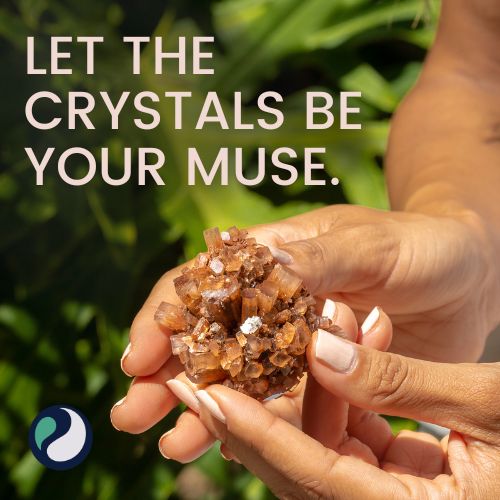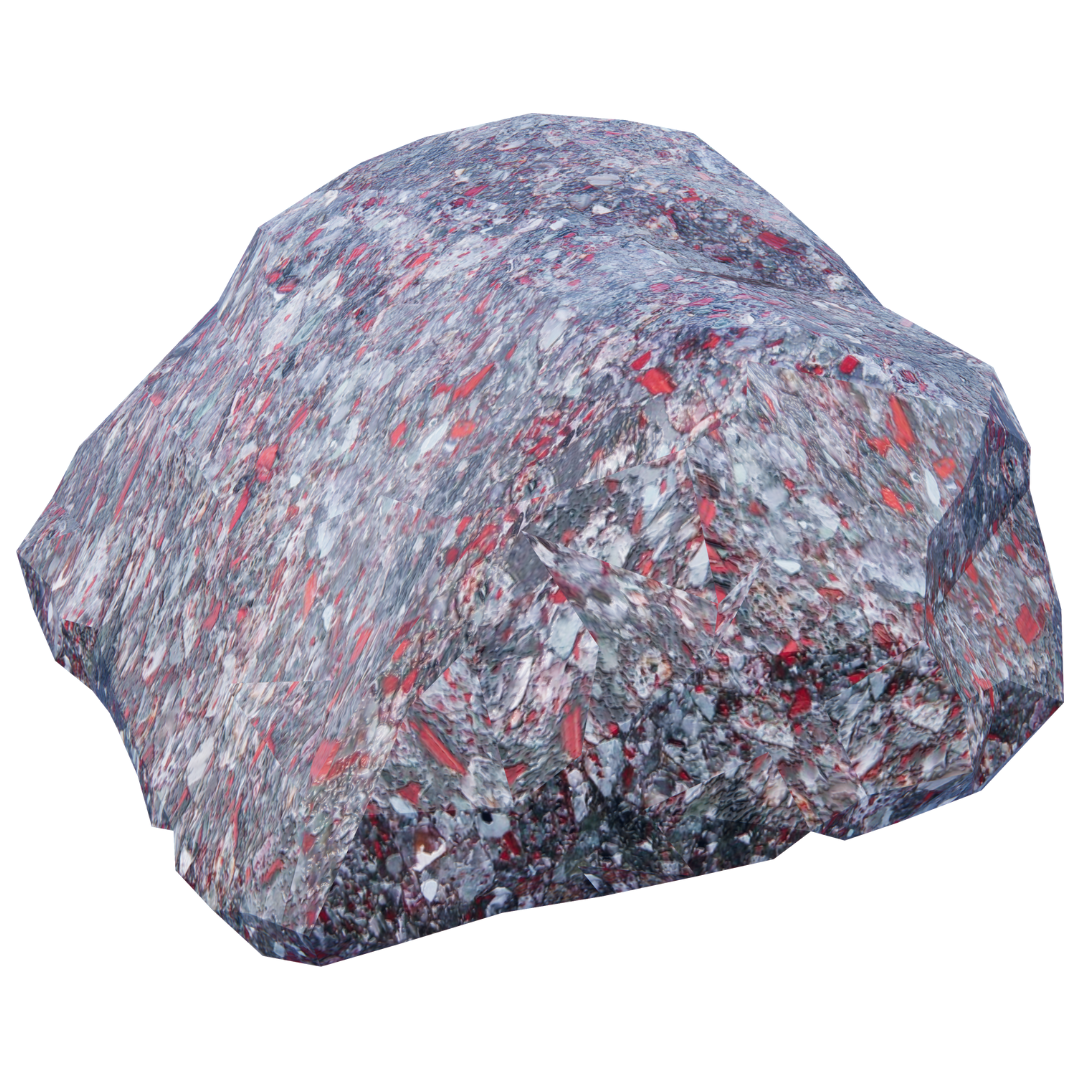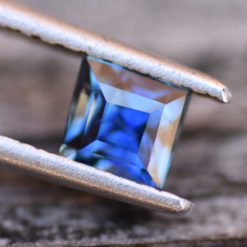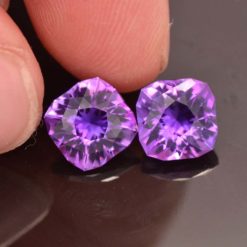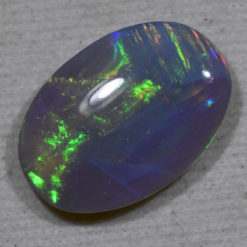No products in the cart.
Gemstone Information
Bloodstone Meaning, Value and Properties
Bloodstone, a captivating gemstone with a rich history and profound significance, has been revered through the ages for its unique beauty and powerful healing properties. This remarkable stone, with its deep green color speckled with vivid red spots, is more than just a visual marvel; it embodies strength, vitality, and a deep connection to the earth. Known also by its ancient name, Heliotrope, bloodstone has fascinated cultures worldwide, serving not only as a decorative jewel but also as a talisman believed to possess protective and life-giving energies.
The allure of bloodstone lies not only in its striking appearance but also in its versatility and significance across various cultures. It is a type of Chalcedony, a mineral that forms in the depths of the earth, where nature’s artistry is at its finest. Bloodstone’s unique coloration and patterns have made it a sought-after gemstone for jewelry, amulets, and even intricate carvings, signifying its value and the craftsmanship it inspires.
As we delve into the meaning, value, and properties of bloodstone, we embark on a journey that transcends mere aesthetics. This guide aims to illuminate the multifaceted nature of bloodstone, from its geological formation and historical significance to its metaphysical properties and practical uses in contemporary life. Whether you are a collector, a lover of gemstones, or simply intrigued by the mysteries of the natural world, bloodstone offers a fascinating glimpse into the beauty and power that lie beneath the earth’s surface. Join us as we explore the enduring legacy and the transformative potential of this extraordinary gemstone.
What is Bloodstone?
Bloodstone, a remarkable gemstone celebrated for its deep green hue interlaced with speckles of red, stands as a testament to nature’s artistry. This distinctive appearance, reminiscent of drops of blood against a dark green backdrop, not only gives the stone its name but also contributes to its mystique and appeal. Bloodstone is primarily composed of chalcedony, a form of quartz that is treasured for its durability and glossy luster, with the red inclusions typically being deposits of iron oxide or red jasper.
This gemstone is also known by its ancient name, Heliotrope, derived from the Greek words for “sun” and “to turn,” reflecting ancient beliefs in its ability to reflect sunlight. Beyond its physical allure, bloodstone carries a wealth of history, imbued with significance and symbolism across various cultures. It has been used throughout the ages not just as an adornment but as a powerful amulet believed to protect and heal.
The mineralogical characteristics of bloodstone allow for a fascinating diversity in its appearance, with no two stones exactly alike. This variability contributes to its unique value among collectors and enthusiasts alike. Its formation process, occurring deep within the earth, involves the slow crystallization of silica-rich fluids in cavities and fractures, leading to the creation of bloodstone’s characteristic deep green matrix punctuated by red spots.
Bloodstone’s hardness, measured at 6.5 to 7 on the Mohs scale, makes it both a durable and practical choice for jewelry and ornamental objects. This resilience, coupled with its striking beauty, has made bloodstone a favorite material for artisans and craftsmen throughout history, evident in its use in seals, cameos, and various decorative items.
Historical Significance
The allure of bloodstone extends far beyond its physical properties, reaching deep into the annals of history where it occupies a place of reverence and mystique. This gemstone’s journey through time reveals its enduring significance across various cultures, underscoring its role not merely as an object of beauty but as a symbol of power, healing, and protection.
In ancient civilizations, bloodstone was imbued with profound spiritual and medicinal properties. The Greeks and Romans, fascinated by its striking appearance, believed it to possess magical qualities. They wore bloodstone amulets to protect against evil and to bring about change. The red speckles against the dark green were thought to symbolize the blood of Christ to early Christians, leading to its use in sculptures and amulets to promote healing and divine protection.
Bloodstone’s reputation as a powerful healing stone is perhaps one of its most enduring legacies. In the Middle Ages, it was believed to have the ability to staunch bleeding, purify the blood, and heal wounds, making it a prized possession among warriors and athletes. Alchemists and healers also valued bloodstone for its supposed ability to cleanse the blood and draw off poisons, associating it with vitality, energy, and longevity.
The historical significance of bloodstone is also marked by its presence in royal collections and significant artifacts. Its use in seals and signets, prized for both its beauty and hardness, symbolized authority and nobility. This practice extended into the Renaissance, where bloodstone was often carved into intricate cameos and intaglios, capturing the artistic and cultural ethos of the era.
Furthermore, bloodstone’s connection to folklore and legend has cemented its place in cultural history. Tales of its protective powers and ability to confer strength and courage to its bearer have been passed down through generations, blending myth with the stone’s tangible attributes.
Today, bloodstone continues to be revered not only for its aesthetic qualities and historical significance but also for its symbolic meaning. It serves as a bridge to the past, carrying with it stories of heroism, faith, and the enduring belief in the power of the natural world to influence human life. As we appreciate bloodstone in modern times, we also pay homage to the rich tapestry of history and human experience that it represents, making it a gemstone of not only physical but also historical and cultural value.
Healing and Metaphysical Properties
Bloodstone, with its mesmerizing interplay of deep green and vivid red, is not just a stone of beauty but also of profound healing and metaphysical properties. This gemstone has been revered since ancient times, not only for its aesthetic appeal but for its believed ability to influence physical well-being and spiritual harmony. Its significance in healing and metaphysical practices is deeply rooted in the lore of cultures around the world, making it a cornerstone in the world of gemstone therapy.
Physical Healing Properties
Among the myriad of healing attributes ascribed to bloodstone, it is most famously known for its purported ability to purify the blood. Ancients believed that carrying or wearing bloodstone could improve circulation and detoxify the blood, enhancing overall physical health and vitality. This belief stems from the stone’s association with life-giving energies, attributed to its blood-like inclusions. Moreover, bloodstone is also thought to bolster the immune system, offering a protective shield against ailments and assisting in the recovery process from illnesses and injuries. Its vitality-enhancing properties are said to invigorate and energize the body, making it a popular talisman for boosting endurance and physical strength.
Mental and Emotional Healing
Bloodstone’s influence extends beyond the physical, touching the realms of mental and emotional well-being. It is believed to be a powerful grounding stone, providing emotional stability and clarity of mind. Those who turn to bloodstone often seek its support in overcoming fears, anxiety, and feelings of impatience. Its grounding effect is said to help in centering and calming the mind, fostering decision-making processes that are more aligned with one’s true intentions and emotions. Additionally, bloodstone is attributed with properties that encourage courage, selflessness, and idealism, aiding individuals in acting in the present moment with compassion and integrity.
Spiritual and Metaphysical Attributes
In the realm of spiritual and metaphysical beliefs, bloodstone holds a place of honor. It is considered a stone of courage, purification, and noble sacrifice. Its energy is said to stimulate the root chakra, grounding spiritual energy and fostering a sense of security and trust in the physical world. Bloodstone’s connection to the heart and root chakras also promotes a harmonious balance between the earthly and the divine, encouraging altruism and a heightened sense of spirituality.
Bloodstone is often used in meditation practices to bring about spiritual insights and to foster a sense of interconnectedness with all life. It is believed to enhance intuition and creativity, opening the mind to receiving divine guidance and inspiration. The stone’s powerful grounding energy also makes it an excellent tool for spiritual grounding, helping practitioners to remain present and focused during their spiritual work.
Where is Bloodstone Found?
Bloodstone, a gemstone as rich in history as it is in beauty, is sourced from various parts of the globe, each location adding its unique characteristics to this fascinating gem. The quest for bloodstone takes us on a journey to remote corners of the world, where nature’s processes have conspired to create this symbol of strength and vitality. This section explores the primary locations where bloodstone is found, highlighting the global tapestry that contributes to the availability and diversity of this cherished stone.
India
India is renowned for its deposits of high-quality bloodstone, particularly in the regions of Karnataka and Orissa. Indian bloodstone is celebrated for its intense green color and profusion of red spots, which are often vivid and evenly distributed. The quarries in India have been a significant source of bloodstone for centuries, contributing to the stone’s prominence in both ancient and modern jewelry and decorative arts. The craftsmanship of Indian artisans in working with bloodstone is equally noteworthy, with a long tradition of carving intricate designs and motifs that showcase the stone’s natural beauty.
Australia
Australia’s rich mineral reserves include significant deposits of bloodstone, primarily found in the Katherine region of the Northern Territory. Australian bloodstone exhibits a darker hue of green and a unique pattern of red speckles, distinguishing it from its counterparts. The rugged landscapes of Australia provide a fitting backdrop for the mining of this robust gemstone, which is often associated with the country’s vast and untamed wilderness. Australian bloodstone is prized for its distinctive appearance and the connection to the ancient land it embodies.
Brazil
Brazil, with its vast and diverse geological formations, is another important source of bloodstone. The Brazilian specimens are known for their bright green base and generously distributed red spots, often featuring a wider range of colors within the stone, including yellows and browns. Found in the Minas Gerais region, Brazilian bloodstone adds to the country’s reputation as a treasure trove of gemstones. The warm, tropical climate of Brazil seems to imbue the bloodstone found there with a vibrant energy that is reflected in its use in jewelry and healing practices.
Other Locations
While India, Australia, and Brazil are among the most notable sources of bloodstone, this gemstone is also found in smaller quantities in other parts of the world. Locations such as China, Madagascar, and the United States have their own deposits, contributing to the global diversity of bloodstone. Each region imparts its unique signature on the stones it produces, adding to the rich palette of colors and patterns available to collectors and enthusiasts.
Bloodstone’s Value and Jewelry Use
Bloodstone, with its deep, earthy allure and speckled canvas of red, holds a unique place in the world of gemstones. Its value in the realm of jewelry and personal adornment is not just monetary but also historical and aesthetic, reflecting the stone’s multifaceted nature. This section delves into the factors that contribute to bloodstone’s value and its esteemed use in jewelry, showcasing how this ancient gem continues to captivate and adorn those who cherish its timeless beauty.
Factors Influencing Bloodstone’s Value
The value of bloodstone, like that of many gemstones, is influenced by several key factors, including color, clarity, cut, and size. The most sought-after bloodstones are those with a vivid green background, densely speckled with well-distributed, bright red spots. The presence and appearance of these red inclusions, resembling drops of blood, significantly enhance the stone’s aesthetic appeal and, consequently, its value.
Clarity is another important consideration, with higher value placed on stones that lack visible cracks or blemishes, ensuring a smooth, polished surface that enhances the stone’s natural beauty. The cut of the bloodstone also plays a crucial role in revealing its best features, with skilled lapidaries able to accentuate its color contrasts and patterns through careful shaping and faceting.
Bloodstone in Jewelry
Bloodstone’s robustness, rated between 6.5 and 7 on the Mohs scale of hardness, makes it an excellent choice for various types of jewelry. It is resilient enough to be fashioned into rings, pendants, earrings, and bracelets that can withstand daily wear while maintaining their beauty. The stone’s rich historical significance and purported healing properties add layers of meaning to its physical allure, making bloodstone jewelry not just decorative but also symbolic.
Artisans and designers often celebrate bloodstone’s natural beauty by setting it in pieces that allow the stone to take center stage, using metals that complement its deep green and red hues. Silver, gold, and bronze settings are popular choices, each adding a different aesthetic dimension to the bloodstone’s appearance. Bloodstone can be cut into cabochons, a popular choice for rings and pendants, or left in its natural state for a more rustic and organic look.
Bloodstone’s Enduring Appeal
The use of bloodstone in jewelry dates back centuries, with evidence of its use in seals, signet rings, and carved amulets. Today, it remains a favored choice for those seeking jewelry with a connection to the earth and its energies. The stone’s versatility and durability make it suited to both contemporary and traditional designs, appealing to a wide range of tastes and styles.
In addition to its aesthetic and historical value, bloodstone is often chosen for its metaphysical properties, believed to imbue the wearer with courage, health, and vitality. This blend of beauty, history, and meaning contributes to bloodstone’s enduring appeal, making it a gemstone that is not only worn but also treasured.
Care and Maintenance
Bloodstone, with its striking beauty and historical significance, is a gemstone that requires careful attention to maintain its luster and prolong its life. As a durable and timeless jewel, bloodstone can last generations with the proper care and maintenance. This section provides essential tips and practices for caring for your bloodstone jewelry and artifacts, ensuring they continue to enchant and perform their symbolic functions for years to come.
Cleaning Bloodstone
The key to preserving the natural beauty of bloodstone is regular cleaning, which helps to remove accumulated dirt and oils that can dull the stone’s surface. To clean bloodstone:
- Gentle Washing: Use lukewarm water mixed with a mild soap. Avoid harsh chemicals or abrasive cleaners, as these can damage the stone or affect its polish.
- Soft Brushing: Gently scrub the bloodstone with a soft-bristled brush, such as a toothbrush, to reach crevices and remove buildup. Be particularly gentle if the bloodstone is set in jewelry to avoid loosening the setting.
- Rinsing and Drying: Rinse the stone thoroughly under lukewarm water to remove soap residue. Dry it carefully with a soft, lint-free cloth, ensuring it’s completely dry before storage or wear.
Avoiding Damage
Bloodstone, while durable, can still be susceptible to scratches, chips, or other damage if not handled with care. To protect your bloodstone:
- Avoid Harsh Environments: Keep bloodstone away from extreme temperatures and harsh chemicals. Exposure to acids, alkalis, and other aggressive substances can damage the stone or erode its polish.
- Prevent Impact: Avoid wearing bloodstone jewelry during activities that could subject it to sharp blows or scratches. This is especially important for rings and bracelets, which are more exposed to potential impacts.
- Separate Storage: Store bloodstone pieces separately from other jewelry to prevent scratches. A soft pouch or a fabric-lined jewelry box is ideal for keeping each piece safe and secure.
Professional Maintenance
For deep cleaning or if your bloodstone becomes significantly dull or damaged, consulting a professional jeweler is advisable. Professionals can offer services such as re-polishing or resetting stones that ensure your bloodstone’s beauty is restored without risking further damage. Additionally, periodic inspections by a jeweler can help catch any issues with jewelry settings before they lead to stone loss.
Careful Wear
While bloodstone jewelry can be a durable and meaningful addition to any outfit, it’s essential to wear it thoughtfully. Applying cosmetics, perfumes, and hairsprays before putting on your bloodstone jewelry can minimize exposure to potentially damaging chemicals. Moreover, removing bloodstone jewelry before swimming, bathing, or engaging in physical activities can help preserve its natural beauty and integrity.
Conclusion
Bloodstone, with its rich tapestry of color and history, embodies a unique blend of beauty, durability, and mystique. This gemstone, revered across cultures for its deep green hue speckled with vibrant red, has captivated humanity for centuries, serving not only as a cherished adornment but also as a symbol of vitality, courage, and healing. Through the exploration of its meaning, value, and properties, we have journeyed into the heart of bloodstone’s enduring legacy, uncovering the layers that contribute to its significance.
The allure of bloodstone extends beyond its physical attributes, touching on the metaphysical realm where it is believed to offer protection, enhance vitality, and promote healing. Its historical significance, rooted in ancient lore and adorned in artifacts across time, adds a profound depth to its value, making it more than just a gemstone but a piece of history. The global journey to uncover the sources of bloodstone—from the verdant landscapes of India to the rugged terrains of Australia and the lush regions of Brazil—reveals the stone’s widespread appeal and the diverse conditions under which it forms.
In the realm of jewelry and personal adornment, bloodstone’s versatility and durability make it a favored choice for designers and wearers alike. Its care and maintenance, while straightforward, are crucial in preserving the gemstone’s natural beauty and ensuring that it continues to convey its unique blend of aesthetic and symbolic qualities for generations to come.
As we conclude our exploration of bloodstone’s meaning, value, and properties, it becomes clear that this gemstone is more than just a piece of the earth’s crust. It is a testament to the interconnectedness of the physical and metaphysical, the historical and the personal. Bloodstone invites us to connect with the natural world in a profound way, reminding us of the beauty, strength, and resilience that lie within and around us.
Whether you are drawn to bloodstone for its healing properties, its historical significance, or simply its natural beauty, it stands as a gem of unparalleled character. It serves as a reminder of the earth’s capacity to create wonders that not only adorn our bodies but also enrich our spirits. Bloodstone’s journey through the ages is a testament to its timeless appeal, ensuring its place in the pantheon of gemstones for years to come.



